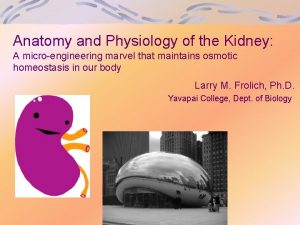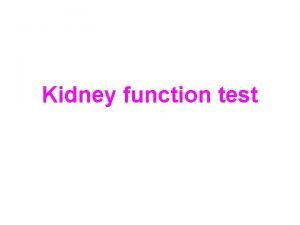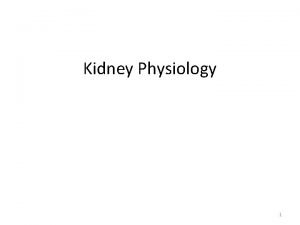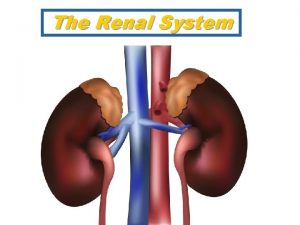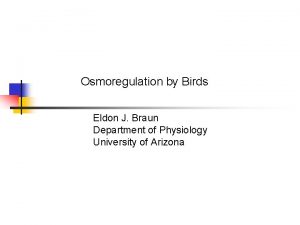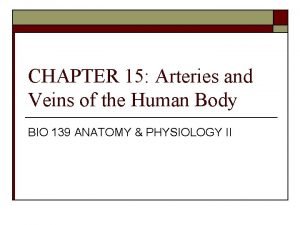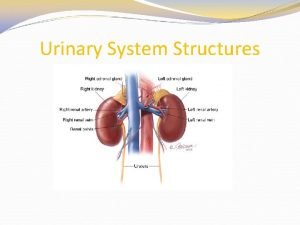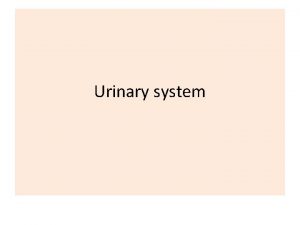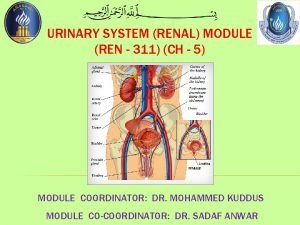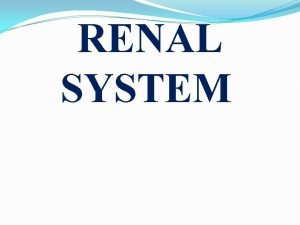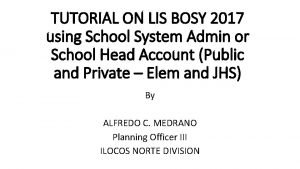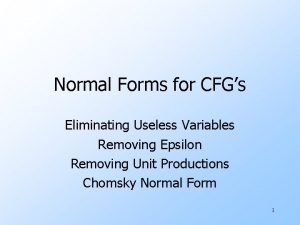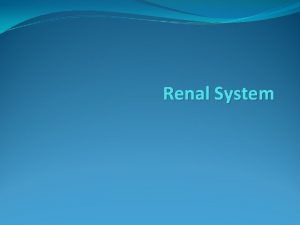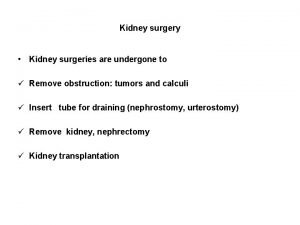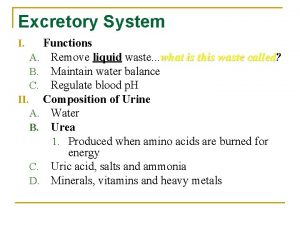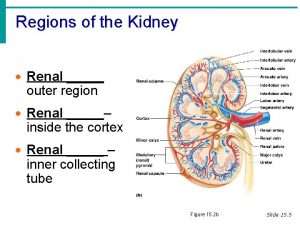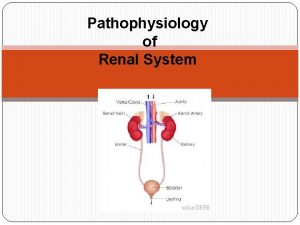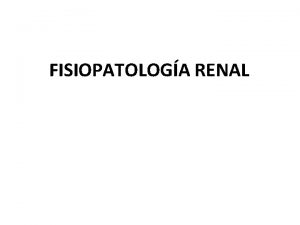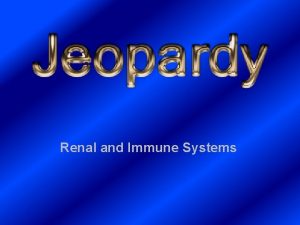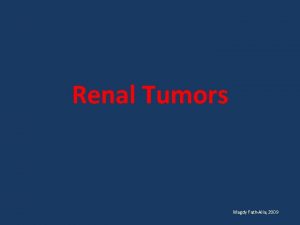Renal System Functions of kidney n Remove waste
















- Slides: 16


Renal System Functions of kidney: n. Remove waste products from the blood n. Control the acid base balance (through HCO 3 - & H+) n. Secrete Hormones and enzyme like erythropoietin and rennin. n. Activates Vitamin D. n. Make G from non CHO sources (make sugar from proteins at time of starvation (gluconeogenesis). )



Renal pyramid Efferent vessel Inferior renal capsule Afferent vessel Renal artery Renal vein Renal hilum Renal pelvis Ureter Minor calyx Nephron Minor calyx Major calyx Renal capsule Renal papilla Inferior renal capsule Renal column

Anatomy of kidneys: Cortex : contain glomeruli ----->filtration Medulla : contain tubules ----->secretion and reabsorption n (each tubule is 5 -6 cm long) * Cortical atrophy : glomerulonephrits * Medullary atrophy : tubular nephritis n Cortical nephron have short loop of Henle n Juxta-medullary nephron Have long loop of Henle and this is important in urine concentration (15 -20%). n In each kidney we have 1 million afferent arteriole & nephron. n n


Functional Anatomy of the Kidney Structure & function of the kidney are closely matched. The kidney is a combination of: 1. Ultrafiltation device (the glomerular apparatus). 2. Epithelium (tubules), which modifies the ultrafiltarte by: - addition (secretion) or - removal (reabsorption). n

n Filtration in kidney is also affected, as systemic capillaries, by Starling forces (Hydrostatic & Osmotic pressure in & out… 4 forces). n Bowman’s capsule stands for the interstitium n To be discussed with regulation of GFR

RBF n n Kidneys are reconditioning organs i. e. Receive too much blood. RBF= 20 -25% of Q →→ This makes the A-V oxygen difference small. Nevertheless, kidneys consume twice O 2/per gm tissue as brain. This O 2 consumption is directly related to Na+ reabsorption. If GFR is high → Na+ reabsorption is high→O 2 consumption is high. When GFR is severely depressed (Acute RF) → decrease need for O 2 If RBF decreases →→acute renal Failure

Tissue Blood flow (ml/g/min) Heart 0. 8 A-V difference Vol% 11 Brain 0. 5 6. 2 Sk muscles 0. 03 6 Liver 0. 6 3. 4 Kidney 4. 2 1. 4 Carotid bodies 20 0. 5

How to measure Renal Plasma Flow (RPF) : RPF : how much plasma enter both kidneys per minute. n We use a substance X that is completely removed (cleaned) from the blood once it reaches the kidneys: i. e. Renal vein concentration of X = 0 n i. e; once comes to the peritubular capillaries is completely secreted. n The substance used commonly here is the PAH (para-aminohippuric acid. ) n

RPF 650 ml is the RPF. n 125 is filtered (GFR). n How much is the filtration fraction? n 525 leave through efferent arteriole and go to peritubular capillaries. n 1 ml/min is the urine output. . n

Example n n n n NOTE : this is not a routine clinical test. So. . if we inject a certain amount of PAH in blood to achieve certain blood concentration. If RPF is 650 ml/min. And urine output is 1 ml/min Then, the concentration of PAH will increase 650 times in the urine. But actually this is not the case. Because 10 % of renal blood goes to nourish the kidney i. e. don’t participate in the renal function…. don't reach the glomeruli So 585 ml/min (90%) is the effective RPF and 650 ml/min (100%) is called true or total RPF. True = effective / 0. 9.

PHA CURVE for FILTRATION and SECRETION : n n n n Filtration is passive. Secretion is active (saturation). Filtered load of “x” : is how much of “x” is being filtered/minute. Filtered load is proportional to its plasma conc. (linear) Since GFR = 125…………filtration counts for 125/650 = 20 % of excretion of PAH in urine. Secretion counts for 80 %. Secretion exhibit Tmax; (Transport maximum. ) The excretion curve is the sum of the above two curves.

PHA CURVE for FILTRATION and SECRETION : 140 120 100 80 60 excreted 40 secreted 20 Filtrated 20 40 60 80 100 120 140
 Res extra commercium
Res extra commercium Teoria do nefron intacto
Teoria do nefron intacto Inside a kidney the ureter expands as a renal pyramid
Inside a kidney the ureter expands as a renal pyramid Vasa recta vs peritubular capillaries
Vasa recta vs peritubular capillaries Function of kidney
Function of kidney 7 functions of the kidney
7 functions of the kidney 7 functions of the kidney
7 functions of the kidney Kidney organ system
Kidney organ system Renal portal system
Renal portal system Renal portal system
Renal portal system Kidneys location and structure figure 15-2
Kidneys location and structure figure 15-2 Urinary system also known as
Urinary system also known as Renal system
Renal system Papillary duct
Papillary duct Lis dep
Lis dep Section view definition
Section view definition Eliminating useless symbols
Eliminating useless symbols


